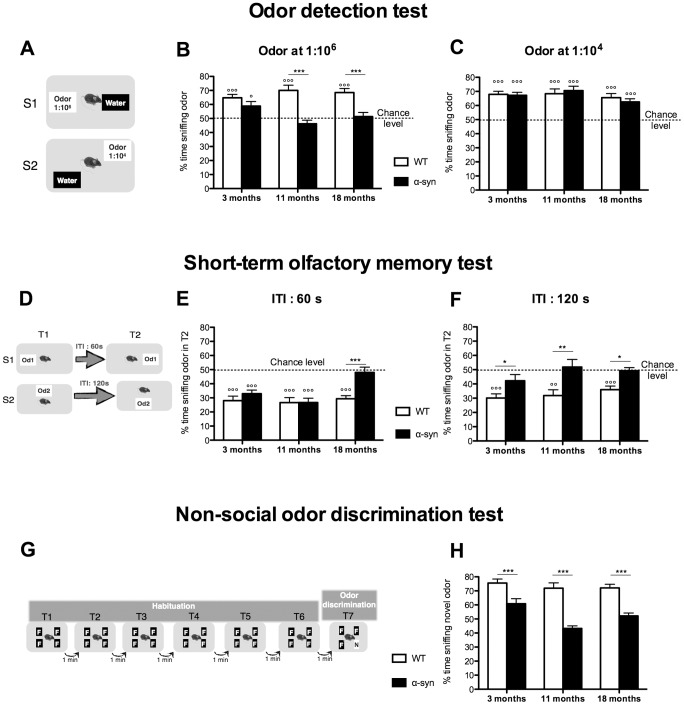Figure 5. Olfactory deficits are age-dependent. A-C: Odor detection test.
Description of the protocol consisting of 2 sessions (S). B. Percentage of time spent sniffing the odor at the concentration of 1∶106 (session 1). WT mice aged 3, 11 and 18 months could detect the odor and the percentage of time sniffing the odor was significantly different from the chance level (50%) (°°°p<0.001). On the contrary, α-syn mice are progressively impaired in detecting the odor. Whereas at 3 months transgenic mice spent more time sniffing the odor compared to the chance level (p<0.05), from 11 months of age their scores no longer differed from the chance level (p>0.05) and the percentage of time spent by α-syn mice to sniff the odor is significantly different from WT mice (two way ANOVA). Statistics: One-sample t-tests to compare each value to chance level (50%) (°p<0.05, °°°p<0.001). Two-way ANOVA: age, p = 0.49, F(2,70) = 0.71; genotype, p<0.0001, F(1,70) = 40.21; age×genotype, p = 0.016, F(2,70) = 4.42; Bonferroni post-hoc (***p<0.001). C. Percentage of time spent sniffing the odor at the concentration of 1∶104 (session 2). Both WT and α-syn mice aged 3, 11 and 18 months can detect the odor at the concentration of 1∶104 and their percentage of time sniffing the odor is significantly different from the chance level (°°°p<0.001). Moreover, there is no significant difference between the genotypes (two-way ANOVA p>0.05). Statistics: One-sample t-tests to compare each value to chance level (50%) (°°°p<0.001). Two-way ANOVA: age, p = 0.12, F(2,70) = 2.15; genotype, p = 0.83, F(1,70) = 0.045; age×genotype, p = 0.64, F(2,70) = 0.45. D-F: Short-term olfactory memory test. D. Description of the protocol consisting of 2 sessions (S). E. Session 1 with an inter-trial interval of 60 s. Percentage of time spent sniffing the odor during T2 (trial 2) compared to the total time spent sniffing during both trials. All groups of WT mice aged 3, 11 and 18 months as well as α-syn mice aged 3 and 11 months remember the odor during the 2nd exposure and their percentage of time sniffing the odor during T2 is significantly different from the chance level (50%) (°°°p<0.001). However, from 18 months of age, α-syn mice are impaired in remembering the odor during the 2nd exposure (one-sample t-test, p>0.05) and the percentage of time spent sniffing the odor during T2 is significantly higher compared to 18 month-old WT mice (two-way ANOVA, p<0.001). Statistics: One-sample t-test to compare each value to chance level (50%) (°°°p<0.001). Two-way ANOVA: age, p = 0.0010, F(2,70) = 7.63; genotype, p = 0.0032, F(1,70) = 9.32, age×genotype, p = 0.011, F(2,70) = 4.78; Bonferroni post-hoc (***p<0.001). F. Session 2 with an inter-trial interval of 120 s. Percentage of time spent sniffing the odor during T2 compared to the total time spent sniffing during both trials. All groups of WT mice aged 3, 11 and 18 months remember the odor during the 2nd exposure and their percentage of time spent sniffing the odor during T2 is significantly different from the chance level (one-sample t-tests, °°°p<0.001). On the contrary, α-syn mice aged 3, 11 and 18 months, are all impaired in remembering the odor during the 2nd exposure (one-sample t-tests, p>0.05) and the percentage of time spent sniffing the odor during T2 is significantly higher compared to WT mice of the same age (two way ANOVA, *p<0.05, **p<0.01). Statistics: One-sample t-tests to compare each value to chance level (50%) (°°p<0.01, °°°p<0.001). Two-way ANOVA: age, p = 0.13, F(2,70) = 2.12; genotype, p<0.0001, F(1,70) = 26.86; age×genotype, p = 0.53, F(2,70) = 0.64; Bonferroni post-hoc (*p<0.05, **p<0.01). G-H: Odor discrimination test. G. Description of the protocol consisting of 6 habituation trials and one odor discrimination trial. H. Percentage of time spent sniffing the novel odor. At 3, 11 and 18 months, α-syn mice spend significantly less time compared to age-matched control mice to sniff the novel odor suggesting that they are impaired in their ability to discriminate the novel odor (two-way ANOVA, ***p<0.001). Statistics: Two-way ANOVA: age, p = 0.0028, F(2,70) = 6.42; genotype, p<0.0001, F(1,70) = 77.78; age×genotype, p = 0.077, F(2,70) = 2.66; Bonferroni post-hoc (***p<0.001). For all tests, N = 14 for group aged 3 and 18 months; N = 10 for group aged 11 months.

